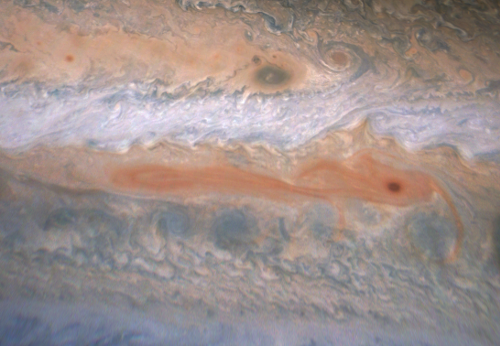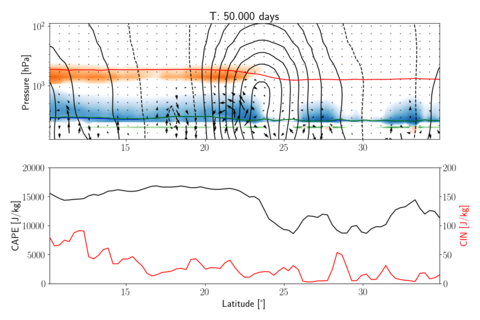- Florida Institute of Technology, Aerospace, Physics and Space Sciences, United States of America (rshankar2012@my.fit.edu)
A fundamental challenge in the study of jovian atmospheres is the structure of the deep atmosphere, where the dynamics strongly influence the upper-troposphere. The clouds aloft obscure the deeper layers, making them difficult to observe without an atmospheric probe like Galileo. Nevertheless, the effect of the deep atmosphere is evident in the changes to the upper level clouds, either in short timescales, through the formation of convective plumes, or over long timescales in the case of planetary scale disturbances, which cause darkening/brightening of entire cloud bands (Fig 1). In the Pioneer and Voyager era, plumes of volatiles were observed to erupt from the deep atmosphere regularly, prompting the question of the strength of the internal heat flux within Jupiter’s atmosphere, and the role of moist convection in Gas Giant atmospheres.

Fig 1: JunoCam image of the jet region where moist convective activity has led to planetary scale disturbances.
These plumes have been observed repeatedly near the eastward jet centered around 23.7° N latitude, in the between the North Tropical Belt and Zone. A set of plumes rise above the cloud deck and lead to the formation of a planetary-scale disturbance near the jet peak over several weeks (e.g., Sanchez-Lavega et al. 2008, 2017). Analysis of cloud formation on Jupiter considering the abundances of various condensible species revealed that the most likely source of these convective events was the deep water cloud which contains both the high density of volatiles and necessary convective potential to breach the upper cloud deck (Hueso et. al, 2002).
Preliminary modelling efforts of this region with the EPIC cloud scheme have yielded interesting results (Sankar et. al 2018, 2019). On perturbing the atmosphere, we noticed that rapid cloud formation was confined to narrow bands of latitude. To investigate this, we calculated the value of the Convective Available Potential Energy (CAPE) of water from the model output. We observed that the convective potential was stronger in regions within the jet and the North Equatorial Belt, which was primarily due to the strength of the jet affecting the thermal structure of the atmosphere. Cloud growth and formation of instabilities (seen as rapid cloud formation in the model) were stronger in regions of high CAPE, and cloud formation was supressed in regions of low CAPE (Fig 2).
In this study, we use the Explicit Planetary Isentropic Coordinate (EPIC) atmospheric 3-dimensional general circulation model (GCM) to study the formation of Jovian moist convective events, using an active cloud microphysics scheme. We have updated this scheme using the Relaxed Arakawa-Schubert (RAS) moist convective scheme (Moorthi and Suarez, 1992) to parameterize sub-grid scale moist convective tendencies. The scheme diagnoses the changes in cloud mass and temperature due to the formation of several convective towers within a grid cell, which allows use to account for convective cumulus formation without having to directly resolving convective updrafts in our model.

Fig 2: Meridional slice of simulation output showing cloud formation (top panel) and CAPE/CIN (bottom). Ammonia is orange-red and water is blue. The red line shows the level of neutral buoyancy and green line shows the level of free convection for a parcel starting at the base of the water cloud (~4 bars).
We focus on the region between 10° and 35° N, which encloses the jet at 23.7 N where plume formation has been observed several times. We initialize the atmosphere with different abundances of both water and ammonia, which are both treated as pure condensibles in our model, to understand the effect of deep abundance on the development of these convective outbursts. We will present our results from our test case before and after the addition of the moist convective scheme, and lessons learned from porting the scheme for use in gas giant atmsopheres.
How to cite: Sankar, R., Klare, C., and Palotai, C.: Moist convection in Jupiter's fastest jet, Europlanet Science Congress 2020, online, 21 Sep–9 Oct 2020, EPSC2020-469, https://doi.org/10.5194/epsc2020-469, 2020.

